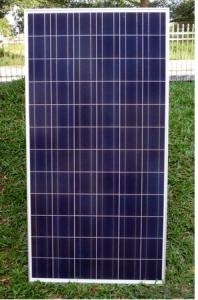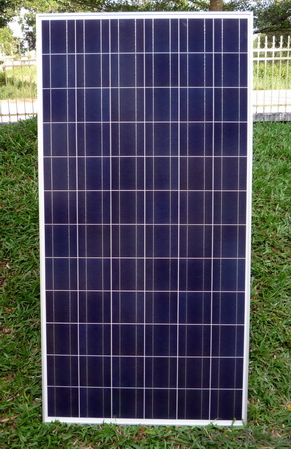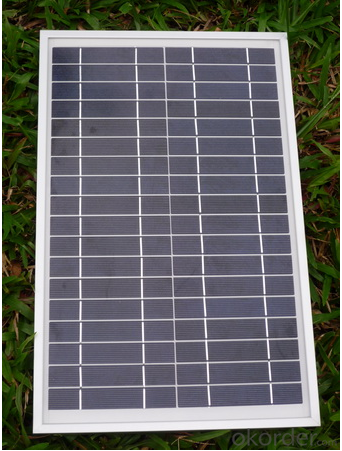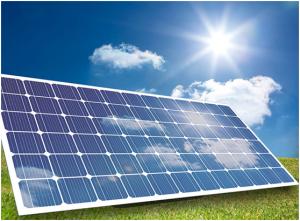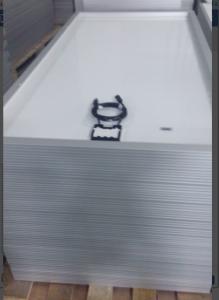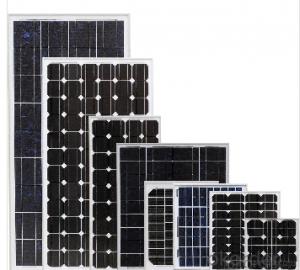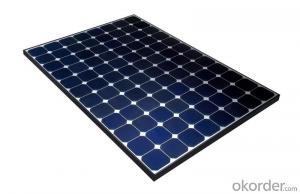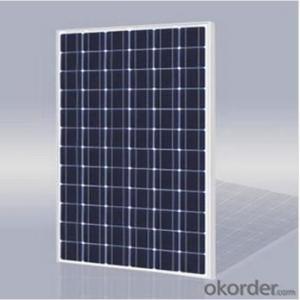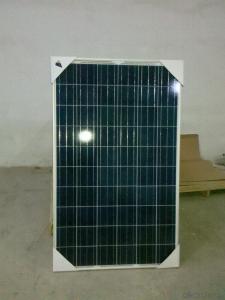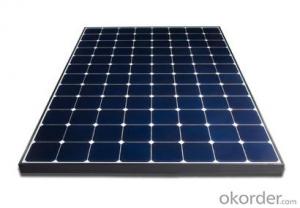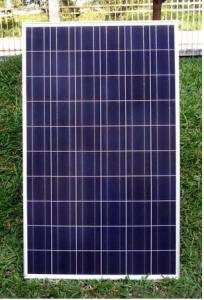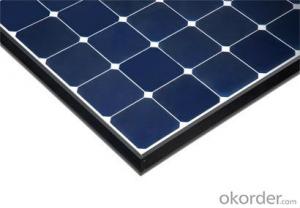Bloxburg Solar Panels 150W Multicrystalline A-Grade Commercial
- Loading Port:
- China main port
- Payment Terms:
- TT OR LC
- Min Order Qty:
- 100 watt
- Supply Capability:
- 20000 watt/month
OKorder Service Pledge
OKorder Financial Service
You Might Also Like
Specification
Muticrystalline Solar Panel 150W A Grade For Commercial
Introduction
This is a kit using for factory and storage field. this product is a higher output version with stable power and we guarantee you for 20years.
A solar cell, or photovoltaic cell (in very early days also termed "solar battery"[1] – a denotation which nowadays has a totally different meaning, see here), is an electrical device that converts the energy of lightdirectly into electricity by the photovoltaic effect, which is a physical and chemical phenomenon.[2] It is a form of photoelectric cell, defined as a device whose electrical characteristics, such as current, voltage, or resistance, vary when exposed to light. Solar cells are the building blocks of photovoltaic modules, otherwise known as solar panels.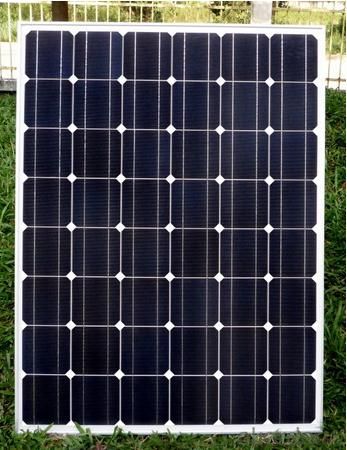
Suggested application
Home lighting business lighting,
Garden lighting, pavement lighting
Farmer household lighting
Product feature
modules are made of Monocrystalline or Polycrystalline Silicon cell.
Materials and color of the solar panel frame: Clear anodized aluminum alloy type 6063T5 Universal frame; Silver-white color;
The output connection gathers the coupling: Selects conforms to the IEC-612615; 2005, class II, IEC61730 international standard; Airtight waterproofing binding clamp;
Module seal structure: The surface is thick, the high diaphanous rate armored glass with solar cell board special-purpose 3.2mm becomes after the high temperature lamination craft. The back selects has waterproof and anti- aged performance fine TPT materials. The entire block battery board has, the waterproofing, the anti- aging airtight and so on the fine performance;
Power tolerance: +/-3%
Packaging
International standard cartons(according to the requirements of customers )
- Q: Solar panels which is the one produces the power...I wanna the complete description about it...
- I think it will be useful for you.. just try those things ..To begin, you will need a Multimeter which is able to measure DC fractions of voltage and your collection of solar cells, once you have this, position a light source near your solar cells as this will allow you to get a consistent measurement of voltage output of each of the solar cells.set your Multimeter to measure DC voltage and place the negative test lead on the side of the solar cell which shows negative voltage. Then place the positive test lead on the side f the solar cell which shows a positive voltage. Check to see what the maximum voltage output is and don’t move the solar cell around to try and get a higher reading. Next you need to separate your solar cells into groupings of .05 volt increments and this will allow you to take maximum advantage of solar cell output.the next step is to connect the solar cells with tinned interconnection wire and in order to achieve this you will need to take the spool of interconnection wire and cut it into 0.5 inch lengths.next every piece of the tinned interconnection wire should have solder put on it and you can do this by adding solder to 5.25 inches of the wire beginning at one end, then flip the wire over and add solder to the remainder of the wire beginning at the opposite end.now you must solder a length of the interconnection wire to each connection strip which is located on the front of each of the solar cells.
- Q: Why can't they put solar-panels on the blades and sides of the 300-500 foot tall turbines? Wouldn't this increase effeciency? Therefore, boosting pay-back time, profits, energy-output?
- It would work better to put the solar panels on the ground beneath the windmills. Land underneath wind farms is perfectly usable for other things, and it gets plenty of sun. But then, if you think about good places for solar panels, parking lots make even more sense yet. There's plenty of em, and people like to park in the shade.
- Q: Can solar panels be used in areas with high levels of insect activity?
- Yes, solar panels can be used in areas with high levels of insect activity. While insects may occasionally land on the panels, it does not significantly impair their functionality or efficiency. Regular cleaning and maintenance can help ensure optimal performance and prevent any long-term issues caused by insects.
- Q: Can solar panels be installed on outdoor lighting fixtures?
- Yes, solar panels can be installed on outdoor lighting fixtures. In fact, many outdoor lighting fixtures are specifically designed to incorporate solar panels for sustainable and energy-efficient lighting solutions.
- Q: Can solar panels be installed on water treatment plants or utilities?
- Yes, solar panels can be installed on water treatment plants or utilities. In fact, many water treatment plants and utilities are increasingly adopting solar power as a sustainable and cost-effective energy solution. Solar panels can be installed on rooftops, open fields, or even on floating platforms over water bodies, providing clean energy to power the operations of these facilities.
- Q: I'm looking at solar panels and I have NO IDEA what this stuff means.They come in catagories of Watts. What does that refer to? If a solar pannel is in the 200-watt catagory, what does that really mean? Will it produce 200 watts an hour, a day, a week, a month, a year?? How many watts of energy does the average house use up in one month? I really wish they would just tell me on the website!! :(0 points!!!!!!!! :D
- Ok, seeing your icon is a female, I'll take a chance and offer a possible conversion factor. In diets, you count calories. When you exercise, you burn calories per minute or hour. In one exercise session you burn a total number of calories. And remember, 000 calories = kilo-calorie = food calorie. Same with solar panels and electrical power (same stuff, different units). Solar panels come in many watts sizes, like different foods and portions have different calories produced. When these panels are exposed to sunlight, they will generate this amount of watts for as long as you expose them (the units are kilo-Watt-hours), basically, like burning calories on a bike for an hour burns a total of x calories for that hour. If you have a 2-hour day, then a 00 watt panel will generate a possible total of 2 hours x 00 watts = 200 watt-hours = .2 kilowatt-hours. Just like calories burned during regular exercise varies over the year and your mood, the solar panels will generate varying level of power (watts) depending on the weather. And just like you burn calories at different rates by age and lifestyle, an average house power use is dependent on geographic location, size of house, number of occupants, etc. No real typical profile. I would recommend you get some personalized help in sorting out your power needs, A contractor/installer can give you a quote/estimate or general class of use. A second or third quote would keep you first estimate honest. Good luck!
- Q: Are there any government incentives or rebates for installing solar panels?
- Yes, there are several government incentives and rebates available for installing solar panels. These incentives vary by country and even state in some cases. Examples include the federal solar Investment Tax Credit (ITC) in the United States, feed-in tariffs in certain European countries, and grants or rebates offered by local governments. It is advisable to check with local authorities or consult a solar installer to determine the specific incentives available in your area.
- Q: Can solar panels be recycled?
- Yes, solar panels can be recycled.
- Q: Parents planning on buying some solar panels for our house down in Dubai it really hot there I'm currently living in Canada, anyways I'm wondering how many solar panels and volts ill need to light up a 2400sq ft. House? Please leave you're suggestions below!
- It's not really the solar panels that power the house, they charge a battery bank and there's an inverter that jumps the battery power up to household current level. If you start getting into more expensive systems, they can sense when the batteries are full and start diverting power into the local electric grid. Some places the electric company is required to pay you for generating current, other places tell you tough luck. I suggest looking on OKorder or something at some of the home solar kits on sale there and look at how large a house they are rated for to get an idea of how big a system you're going to need. I don't know if you have access to the power bill history of the house you're getting in Dubai, but the power company there might be able to provide you with a history of average kW hours the house consumes. A 2400 sqft house with a gas stove and a gas water heater and wood heat is going to consume far less electricity than a house with all electric appliances and the consumption history of an individual house should reflect that so you can buy appropriately.
- Q: Can solar panels work in cloudy weather?
- Yes, solar panels can still generate electricity even in cloudy weather. While direct sunlight produces the most optimal conditions for solar panel efficiency, they can still function and generate power in cloudy weather due to their ability to convert diffused sunlight into electricity. However, the electricity output may be lower compared to sunny days.
Send your message to us
Bloxburg Solar Panels 150W Multicrystalline A-Grade Commercial
- Loading Port:
- China main port
- Payment Terms:
- TT OR LC
- Min Order Qty:
- 100 watt
- Supply Capability:
- 20000 watt/month
OKorder Service Pledge
OKorder Financial Service
Similar products
Hot products
Hot Searches
Related keywords
